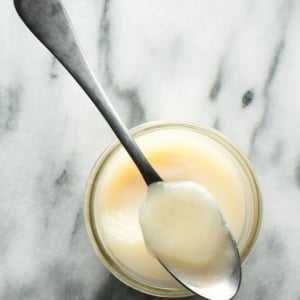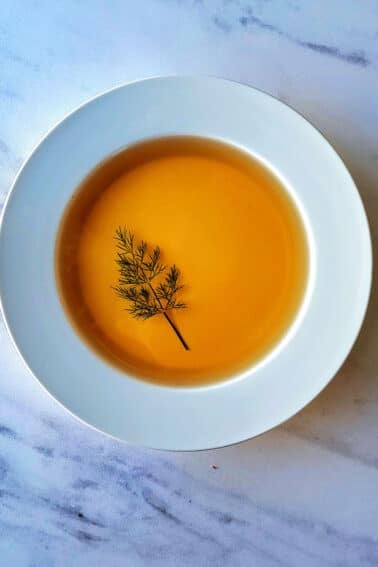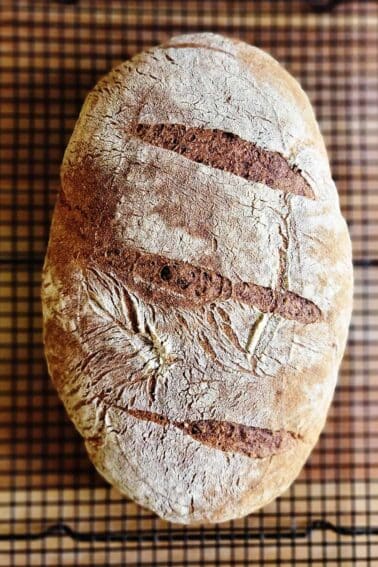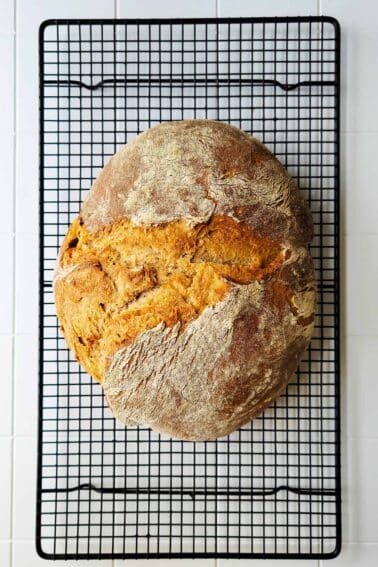How to Render Duck or Goose Fat
December 07, 2015 | Updated November 02, 2020
As an Amazon Associate I earn from qualifying purchases.

Domestic ducks and geese are the pigs of the air. They lay on thick layers of clean-tasting, delicious fat that is healthier for you than lard — and remember that fresh-rendered lard is healthier for you than butter. Other than fish fat, waterfowl fat is arguably the animal fat that is best for you. Here’s how to render duck fat at home.
If you are using store-bought ducks or geese — goose fat is more or less the same as duck fat — no need to worry; it’ll be good. If you are using wild ducks or geese you need to be a bit more careful.
The key is what they are eating. I am blessed with ducks and geese that winter in Northern California among the rice fields. It is not uncommon to see pintails or mallard with such a thick layer of white, rice-built fat that they look like little domestic ducks. I cook with it all year long. Corn-fed mallards will lay on more yellowish fat, and the birds shot out of the pea and barley fields of Canada are legendary. I’ve even shot obese wood ducks that had been eating acorns.
Your best bets are, in order of preference: pintails, wood ducks, specklebelly geese, green-winged teal, mallards, canvasbacks, wigeon, gadwall and other birds. In general, avoid spoonies unless you are absolutely certain they’ve been eating rice.
Avoid all sea ducks and most divers. Canada geese can be OK, but I generally won’t render fat from them.
So where do you get this wondrous fat?
Mostly from the pope’s nose, the tail of the bird. You cut this off and clean it well — after all, it includes the animal’s poop chute — and then cut it into pieces. You will also find good stores of fat around the bird’s gizzard and at the base of the neck.
Also remember that if you are parting your birds out (and have plucked them), you can slice a lot of fatty skin off the duck’s back. And if the breast is pretty shot up? Pull the skin off and render that, then use the beat-up meat for burger. All in all there’s quite a bit of fat to be had if you know where to look.
Here is a quick video we made on how to render duck fat:
Once you have your fatty bits, wash them all in cold water and cut them into smallish pieces with shears. Put them all into a frying pan set over medium heat. Add just enough water to cover the fatty bits. The fat will begin to render out immediately into the water, which, as the water boils, will evaporate — but not before rendering enough fat to allow the bits to continue rendering slowly without scorching.
Once the water boils away, drop the temperature to low and watch the fat, which will be yellow and milky. At some point, about 30 to 45 minutes later, the fat will turn clear. Now you’re ready.
Set up a strainer over a glass container to hold the fat in; I use pint Mason jars. Set a paper towel into the strainer and pour the contents of the pan into it. All the impurities will stay with the paper towel. When the fat is done dripping, about 15 minutes, pour the liquid gold into a container, cover it and keep it in the fridge. It will last a year there, and indefinitely in the freezer.
What to do with the leftover cracklins? They are a little hard to eat like pork cracklins’, so I use them in my recipe for Mexican chicharron en salsa verde.
Once you have your fat, use it to cook with. It’s great with potatoes, to cook greens in, to start the pan when you cook a duck breast, and it is indispensable when making duck confit.
How to Render Duck Fat
Ingredients
- 1 pound duck fat with skin
- Water to cover
Instructions
- Chop the duck fat into little pieces with kitchen shears. If you are working with the tails, snip away the oil gland. It's OK to have bones here and there, but if you are going to later eat the cracklins', you will want to remove any bones.
- Put the pieces in a pot and cover with water by just a little. Turn the heat to high, stir well and boil this. As the water boils away, you will want to reduce the heat so that ultimately, the pieces are frying in their own fat.
- Later, that fat will turn from milky to clear, and the bubbling will slow down. Strain the fat off the cracklins. Pour the clean fat into a Mason jar and refrigerate for up to 6 months, or freeze indefinitely.
Nutrition
Nutrition information is automatically calculated, so should only be used as an approximation.






Hey Hank-been following and learning from you for a year-last year did a Canada goose , just baked whole in the oven before doing any research and got loads of very white yummy fat from a Canada goose that was probably local (NW Montana) in forest sloughs far from grain -doing a Canada and 4 mallards today from the plains, getting very yellow fat and the goose not as tasty as last year-any ideas for the difference?-making jerky soon from your recipes, thanks, and always promoting your site
I render our home raised chicken fat all the time. My husband has a dairy allergy, we call it chicken butter. It’s delicious. I never add water to it though, I’m going to try that next time I render. Thanks!
Hi! I have about a quarts of golden duck fat that I rendered in July. I didn’t keep it in the fridge, but it still smells fine. If it had gone rancid in this time, would I be able to smell it? Like rancid nuts or vegetable oil? Is there any way to tell if its gone rancid or isn’t safe to use? I want to use it tomorrow to confit 24 duck wings I have. I can render more fat if necessary. I have about 3 gallons of frozen skins, but if I can use what I already have, that’d be preferable! I’m not sure though if its okay to use the duck fat that’s not been refrigerated, even though my best judgement tells me its fine! I’d appreciate yours!
Shoshana: Um… that’s weird. I wouldn’t eat it, but I am very surprised it doesn’t smell bad.
Does this work with Goose also? The stuff I buy on Amazon is $$ and this sounds like a good alternative.
Dawn: Of course. In the kitchen, there is almost no difference between ducks and geese.
Thanks for the quick reply, Hank. But I DID have only crystal clear, golden fat in the pan after almost 2 hours, and there was no steam coming off of it, and my skin pieces were nice and crispy and dark golden brown (yum)… so I’m pretty sure it was rendered down properly. Quite the mystery. I’m using the golden fat off the top for fried potatoes, and will decide about the remainder when I get there. Meanwhile, storing in fridge “just in case”.
Diane: Weird! Never had that happen.
Help, please! I rendered my duck fat just like in your video (took an hour-and-a-half) and had beautiful golden fat in my jar when done. Left it sit on the kitchen counter overnight and went to bed. But next morning, it had separated into two equal layers; the top layer a. clear, golden yellow and the bottom layer a milky, pale cream color. What do I have??
Diane: Huh. Sounds to me like you did not render it enough. Put it all back into the pot and keep heating it over medium-low heat. When it’s ready, the fat should have no more water in it and become crystal clear.
Please show a recipe for slow roasted duck for a fat wild bird shot by my son this morning. It is cleaned and will be available for me to roast tomorrow. Thank you. PS It is a wood duck; we have many oak trees about (acorns) and my son thinks it was a northern duck, judging by its plumpness.
Brenda: Please use the search box at the top of the screen to search for “slow roasted duck.” You’ll find it! 😉
Any particular reason you do not render fat from canadian geese? I just shot some for the first time (first time waterfowl at all) and just cutious about getting thr most use out of them
Becky: I do, from time to time, but Canada geese can be very variable, so some are great, some awful.
Hank,
Enjoying the site immensely. For making venison hamburgers I usually grind in bacon or bacon ends, but I also always collect the bacon grease after making fried bacon and make a small batch of hamburger. For this I have to keep everything pretty much at freezing through the process. I started making duck fat, any reason not to try it as fat in a small venison burger batch? It would be nice to have a purely wild burger. Thanks…
One more question, too… do you get a lot of splattering as the last of the water is boiling out? I did. Should I have had the heat lower? Or let it happen and don’t worry about it? (Or use a splatter screen??)
John: Yes, turn the heat way down when it’s just fat.
How about buffleheads? They’re divers/sea ducks, but have lots of white fat…
Thanks!
John: Not a fan. Majority of their diet is invertebrates, and they can be very fishy.
How long does it keep?
Jill: Forever in the freezer, about 9 months in the fridge.
Once the duck fat is in the jar, does it need to be water or steam bath canned to seal it or just placed in the fridge?
Nick: Just put in the fridge.
I bought an 8 lb capon (aka Male chicken, aka neutered rooster), organic, free range.. and ended up with 2 lbs of fat. The capon is a nicely marbled roaster meat, usually with lots of fat (it is fed with milk and porridge, hence the fat)… followed this recipe and voila! Just right. Usually I keep the final product in the freezer, it lasts well for a good half a year. I do the same with ghee, butter and goose fat. Just make sure to mark it, incl. the date, and remember where you place it in the fridge.
Can I use duck or goose fat in sausage recipes? Pork fat and most cow fat isn’t kosher so I’m trying to find an alternative
Isaac: no. Use beef fat. Duck or goose fat only works in emulsified sausages like hot dogs.
during the holiday cooking there would be a shout and a slap from the kitchen, where pops had just administered mom’s “free christmas goose.”
the bird rested in the oven supported above an enameled porcelain pan to catch the drippings. sometimes i think dad only made goose for what he called (and he said this with his eyes closed while licking his lips) “goooz greeez.” he would take whatever had shed and place it on the back porch where it would be skimmed each day into a bowl. the result was not as clear as your photo, more of a yellow super soft butter after being refrigerated.
this was in turn slathered onto toasted salt rising bread and the result was delicious. i haven’t been able to find a local bakery that keeps the starter necessary for these loaves for thirty years. still looking, although i no longer have the yeast sensitivity that brought us to it in the first place. it is just a wonderfully “cheese nosed” slice.
Typically how many ducks does it take to get 8oz of duck fat??
Hank,
In lieu of trying to render fat from a few birds at a time, can the fat “pieces” be frozen until such time fat from a dozen or so birds can be rendered at once?
I have never tried rendering the fat from my ducks, but would like to try it. Most times, only a couple of birds per trip would have desirable fat amounts, so I am trying to only have to do the rendering once instead of multiple times.
Thanks and really love your site. Also just asked the wife for your cookbooks for Christmas. Can’t wait until they arrive!
Brad: Absolutely. We do that all the time. And thanks re: cookbooks!
I rendered fat from a farm raised duck and the fat went rancid in just a couple months. I was shocked at how fast it went rancid. I was keeping mine in the refrigerator. Now, I just burn it in an oil lamp.
Tim: Weird. I’ve had wild fat in my fridge in a Mason jar for a year, no problem. And frozen, longer than that.
One trick that I’ve liked for clarifing animal fats is to pour the melted fat into a cup of water. The heavy solids sink to the bottom, but the fat stays floating on top. Put the whole cup into the fridge… when the fat solidifies, you can peel it off the top of the water.
I particularly like doing this with bits of poultry skin, like you say… the fat renders out, and the skin is a lovely snack on toast!